Abstract
In China, as statutory non-cultural relic buildings, the conservation and reuse of historic buildings have received increasing attention in recent years. Among them, the investigation and value evaluation of historic buildings are the basis and core of the conservation work, and many cities have explored related technologies and methods according to local conditions. This paper takes the historic building resources in Xi’an as the research object, with the core of historic building registration and the principles of scientificity and operability. It proposes the methods and basic processes for investigating historic building resources and constructs a step-by-step evaluation system for the historic buildings in Xi’an. This research first formulates a registration standard for the identification and evaluation of historic buildings, then applies the analytic hierarchy process, Delphi method, and fuzzy comprehensive evaluation method to assess the comprehensive value of historic buildings. Finally, it was recognized that the historic building resources are primarily modern and contemporary buildings, playing a significant role in the cultural continuity of the ancient capital, Xi’an. In its value evaluation, emphasis should be placed on the environmental landscape value and socio-cultural value. At the same time, it is necessary to consider the comprehensive value and sub-indicators of historic buildings so that they can guide conservation and adaptation practices in a targeted manner.
1. Introduction
Historic buildings are essential carriers and non-renewable resources that reflect the historical development of society and inherit local history and culture. With the rapid development of urbanization, many historic buildings face the problems of dilapidation, improper use, or even demolition due to the lack of legal conservation. The conservation of these buildings is in severe situations. In 2016, opinions of the State Council on Further Strengthening the Management of Urban Planning, Construction, and Management put forward the idea of “completing the work of delimiting historic conservation area and identifying historic buildings in all cities in about five years work”. Since then, various cities nationwide have competed to investigate and determine historic buildings.
Xi’an, the capital of Shaanxi Province, is located in the Guanzhong Plain in the middle of the Yellow River basin, across the Weihe River in the north, adjacent to the Qinling Mountains in the south, and surrounded by Lishan Mountain (see Figure 1). It is one of the first batch of historical and cultural cities announced by the State Council in 1982. With a history of more than 3000 years, Xi’an is one of the important birthplaces of the Chinese nation and civilization and has rich historical and cultural resources. The cultural relics in Xi’an are mainly ancient ruins, tombs, traditional architectures, and other types that are widely distributed, of high grade, and various types, such as the Mausoleum of the First Emperor of Qin, the Chang ‘an City of Han Dynasty, the Daming Palace of Tang Dynasty. In contrast, Xi’an’s modern and contemporary architectural heritage cannot be compared to the ancient relics in terms of quantity, distribution, and impact on the urban landscape, resulting in a relatively lagging research and conservation field. The research on Xi’an’s modern and contemporary architectural heritage mainly focuses on the primary research stage, such as the investigation and census of the buildings [1,2,3], as well as the research on the relationship between Xi’an’s modern architecture and the city’s history and culture [4,5] and the research on Xi’an’s historical districts, which involves the residential buildings and the regional culture [6,7]. At present, Xi’an’s modern and contemporary architectural heritage has been incorporated into the national conservation system, and two batches of excellent modern and contemporary buildings were announced in 2016 and 2017, respectively, totaling 30. Since 2018, Xi’an has incorporated the conservation of excellent modern architectural heritage into the conservation of historic buildings and announced the first batch of 30 historic buildings in conservation planning for Xi’an Historic City in 2021. At present, the determination of the second batch of historic buildings is being completed.
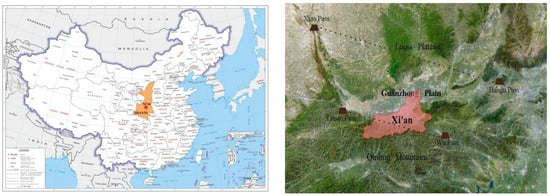
Figure 1.
Location of Xi’an in China.
In the current urban renewal of Xi’an, the contradiction between the conservation of historic buildings and economic development is prominent. “Constructive destruction” often occurs [8], and historic areas and buildings reflecting the traditional style of the city are damaged. The historic urban landscape and skyline of Xi’an, which consists of the Bell Tower, the Drum Tower, the Giant Wild Goose Pagoda, and the Small Wild Goose Pagoda, have been destroyed, making it difficult to continue the city’s historical context (see Figure 2 and Figure 3). The above theoretical and practical dilemmas of Xi’an historic building conservation are attributed to the lack of a correct and objective understanding of the value of historic buildings. Consequently, this paper takes 133 historic building resources in Xi’an that have completed detailed research and information archiving as the research object (including the first batch of 30 historic buildings), with the identification and registration of historic buildings as the core and uses a combination of qualitative and quantitative methods to gradually construct the registration and classification standards for historic buildings, providing a basis for conservation and reuse. This study explores the value cognition and evaluation of historic buildings as a type of heritage conservation that differs from cultural relics. It has important theoretical and practical significance for determining and conserving historic buildings in Xi’an and throughout the country.
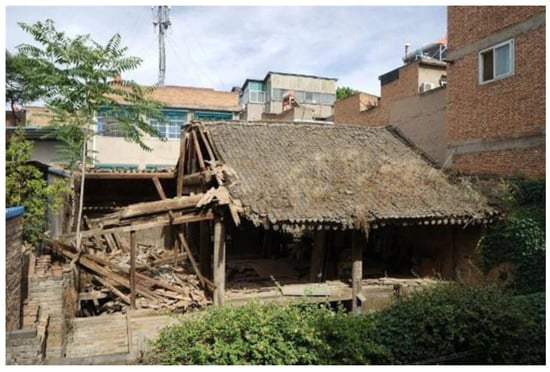
Figure 2.
Dilapidated residential buildings in the historic conservation area.

Figure 3.
Current status of the city skyline around the Giant Wild Goose Pagoda in Xi’an.
2. Research Review
There has always been a difference in the understanding of “Historic Building” between China and the West, and in the early days of China’s architectural heritage conservation research, the concept of historic buildings has never been clearly defined. In a broad sense, historical buildings generally refer to ancient or modern and contemporary buildings with a certain age and conservation value [9]. In the context of heritage conservation in China, it covers cultural and non-cultural relic buildings, and most of the historical buildings mentioned in the academic field belong to this category. However, in China, cultural and non-cultural relic buildings correspond to two sets of independent conservation management systems, and these two types of buildings cannot conceptually encompass each other. Therefore, the “historic buildings” mentioned in this paper refer specifically to non-cultural relic buildings registered for conservation in the Chinese context, and “architectural heritage” refers collectively to buildings with domestic and international conservation value. The relevant research on the concept and value evaluation of heritage in different regions and conservation systems has laid the theoretical foundation for this article.
2.1. Experience and Inspiration of Foreign Heritage Conservation System and Value Evaluation
Western developed countries started conservation research on architectural heritage at an early stage, and their evaluation and conservation systems are relatively comprehensive. Some countries have formed a perfect conservation mechanism from heritage investigation: evaluation to registration at an early stage. For example, the U.K. established the framework of the listing system as early as in 1947 in the Town and Country Planning Act, put forward the value standard of listed buildings, and continuously amended and supplemented it with the development of the urban planning system [10]; France enacted the Malraux Act in 1962 to establish a conservation and reuse planning system (PSMV for short) for a broader range of urban architectural heritage, to investigate and evaluate architectural heritage in historic conservation areas, and then to implement conservation and remediation [11]; Canada formed the “survey-evaluation-decision ” method of architectural heritage conservation in the 1980s, and established a set of value evaluation system based on the essential criteria of architecture, history, environment, practicability and integrity [12]; In the United States, “historic context” is taken as a primary and core concept in cultural heritage conservation, according to which identification, value assessment, registration and other conservation work are developed [13]. In the architectural heritage conservation systems of these countries, the investigation and research, evaluation, and registration can produce coherent results, which can be used for the subsequent conservation planning and achieve a perfect match between theory and practice, which is of reference significance.
2.2. Exploration and Practice of Value Cognition and Value Evaluation of Domestic Architectural Heritage
China’s research on the value of architectural heritage started from exploring the value of cultural relic buildings in the early period of the founding of the country. In the 1960s, China initially established the officially protected site system, and at this time, historical value and revolutionary commemorative significance were the primary basis for value recognition. The 1982 Cultural Relics Protection Law clarified the three fundamental values of historical, artistic, and scientific, laying the foundation for recognizing the value of architectural heritage. The 2015 Principles for the Conservation of Heritage Sites in China added social and cultural values based on the three significant values. With the promotion of urban renewal and urban–rural construction, the research on the value evaluation, conservation, and reuse of architectural heritage has received widespread attention from the academic community. Huang Mingyu (2009) [14] argued that the social and humanistic values should be supplemented based on the three significant values referred to in the Burra Charter, which is close to the classification of heritage values in China. Song Gang (2013) [15] used interdisciplinary research methods to establish a hierarchical structure model of the modern and contemporary architectural heritage ontology and the overall environmental conservation value evaluation system. It argued that emphasis should be placed on evaluating the historical and artistic values of architectural heritage. Changqing (2016) [16] believes that value identification requires the comprehensive application of methods such as anthropology, archaeology, and documentation, while the value attributes of architectural heritage are multi-dimensional, broadly including historical memorial value, sample retention and research value, cultural symbol value, and adaption value. Xu Jinliang (2018) [17] starts from the Axiology to interpret the value relationship, taking the comprehensive value based on the characteristics of architectural heritage information and the functional value based on space as the main line, and expounds its relationship with economic value.
After the legal definition of historic buildings was first clarified in the Regulations on the Protection of Famous Cities, Towns and Villages of Chinese History and Culture in 2008, it began to gradually get rid of the customary reliance on the idea of cultural relics conservation as a new type of heritage conservation. It explored the formation of an independent system in the theory and practice of conservation. At the practical level, the Ministry of Housing and Urban–Rural Development issued the Standards for the Determination of Historic Buildings to provide a reference for identifying and assessing historic buildings in 2016. Subsequently, ten pilot cities for historic buildings, including Beijing, Guangzhou, and Hangzhou were identified to explore the mechanism of historic building census determination, conservation, and reuse and to study the value composition of historic buildings according to local conditions and develop an evaluation system. At the level of academic research, with the progress of the concept of heritage conservation and the expansion of value cognition, research on the value analysis and evaluation system of new historical building types such as excellent modern and contemporary buildings [18,19], vernacular architecture [20,21], industrial heritage [22,23,24], 20th century architectural heritage [25,26] has become more common. The research on the value evaluation method is no longer confined to single qualitative research, and the exploration of the evaluation method combining qualitative and quantitative began in the mid-1990s, which pays more attention to the systematicity and scientificity of the evaluation. With the infiltration and intersection of disciplines, transdisciplinary methods such as the analytic hierarchy process [27], fuzzy comprehensive evaluation method [28], and gray clustering method [29] have been widely used in the field of heritage conservation.
3. Investigation and Characteristic Analysis of Historic Building Resources in Xi’an
Xi’an has rich historical and cultural resources, and the conservation planning for the historic city specifies 13.5 square kilometers of historic urban area, 3 historic conservation areas, 42 historic areas, and 88 historic villages and towns. As the most basic and extensive conservation object in the historic city system, historic buildings must be excavated and conserved to the maximum extent.
3.1. Investigation Basis
The conservation of historic buildings focuses on the conservation of modern and contemporary buildings. Since the government proposed to strengthen the conservation of excellent modern and contemporary buildings in 2004, Xi’an has also continuously promoted the identification and conservation of modern and contemporary architectural heritage. According to statistics, in addition to officially conserved sites, many types of modern and contemporary buildings have been registered and included in the national heritage conservation system (Table 1). These efforts have provided the basis and clues for the comprehensive survey of historic building resources. However, it can also be seen that the number of historic buildings included in the national heritage conservation system is limited and still needs to be further explored.

Table 1.
Basic information on the modern and contemporary architectural heritage of Xi’an included in the national heritage conservation system.
3.2. Methods and Process of Investigation
The investigation work is carried out to comprehensively grasp the overview of historic building resources in Xi’an, including the quantity, distribution, and preservation of historic buildings, profoundly understanding and summarizing the characteristics and values of historic buildings in Xi’an and providing a basis for the registration of historic buildings as well as their conservation and reuse. This study takes the historic building resources in Xi’an as the primary research object. It puts forward the technical route, which includes three main phases: investigation preparation, on-site investigation, and data collation (see Figure 4).
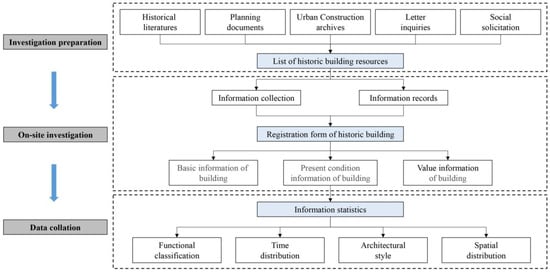
Figure 4.
Flowchart of the investigation.
- Investigation Preparation
To determine the list of historic building resources as comprehensively as possible, firstly, it is necessary to collect and interpret relevant historical literature, planning documents, and urban construction archives, and secondly, the list is screened and supplemented through letter inquiries from relevant units and social solicitation, so that the list of 133 historic building resources of Xi’an is finally determined in the study. At the same time, by interpreting the literature, we can sort out the urban construction context, grasp the city’s core values, and gain an overall knowledge of the city’s historical and cultural background, to guide the accurate judgment of the value carriers in the on-site investigation.
- On-Site Investigation
Drawing on the experience of relevant cities and referring to the archiving standards for immovable heritage, a registration form for historic buildings in Xi’an was designed for on-site investigation, and information collection and recording of historic buildings were carried out for filing. The registration form should reflect the basic information about historic buildings and directly reflect the relevant indicators of registration standards. The main content of the historic building registration form is determined as shown in Table 2.

Table 2.
Content of the historic building registration form.
- Data Collation
After the investigation, it is necessary to integrate the investigation results and conduct data statistical analysis, objectively presenting the quantity, type, and distribution characteristics of historic building resources. Summarize the current status and existing problems of conservation work in Xi’an and take this as a starting point to continuously improve the conservation system of historic buildings.
3.3. Investigation Results and Analyses
Statistical analysis was conducted on the investigation data of 133 historic buildings in Xi’an, with the main characteristics as follows.
3.3.1. Functional Classification and Time Distribution
Historic buildings are of various functional types in Xi’an, covering traditional residences, industrial buildings, office buildings, cultural and educational buildings, commercial buildings, etc. (see Table 3). Among them, industrial buildings are the most numerous and are primarily modern industrial heritage. After the founding of New China, under the guidance of national policies, a large number of critical modern industries settled in Xi’an, and these industrial factories are of good architectural quality and have the characteristics of the times, with military, mechanical, and electrical industries as the main types of industries [30]. The second largest number of cultural and educational buildings was built in the 1950s and 1960s, when the number of colleges and universities in Xi’an increased dramatically according to the central government’s unified plan to relocate colleges and universities from the coastal areas in order to support the anti-war efforts and to protect the country’s educational resources, resulting in the formation of a situation where Xi’an was the center of the five northwestern provinces and districts [31]. Meanwhile, as an ancient cultural capital, Xi’an has built many cultural buildings after China’s reform and opening up to inherit and display the ancient capital’s traditional culture and urban style. In addition, the traditional residence also accounts for a large proportion of historic building resources in Xi’an, mainly in the Ming and Qing dynasties, most of which are poorly preserved and severely damaged. Overall, in terms of time distribution, the proportion of buildings after the founding of the People’s Republic of China reached as high as 80%. In contrast, the number of modern buildings is relatively small (see Figure 5).

Table 3.
Statistics of historic building type and build time in Xi’an.

Figure 5.
The type and period proportion of historic buildings in Xi’an.
3.3.2. Architectural Style
Historic buildings in Xi’an are mainly in Guanzhong traditional architectural style, new Tang style, Soviet architectural style, and Western classical architectural style (see Table 4). As Xi’an is located inland, the degree of modernization is less typical compared to the coastal port city [32]. The architectural styles have been little influenced by Western architectural culture and are mainly based on local traditional architectural styles. Traditional architectural style in Guanzhong District is represented by dwelling houses, which are simple and stable, with a traditional courtyard layout, narrow and long depths, and the spatial characteristics of layers along the longitudinal axis. The new Tang style is represented by cultural and educational buildings, which is the fusion of traditional Tang architecture and modernist architecture, emphasizing traditional spatial awareness and urban design concepts. The Soviet architectural style is represented by architectural works from the “First Five Year Plan” period, such as industrial architectures and cultural and educational architectures, which are primarily symmetrical on the central axis, the middle is high, and the two sides are low. The facade is mostly a three-part composition with embossed line decorations. The relatively rare Western classical architectural style presents strict composition rules and scale and a Western-style in portico, cornice, and pediment.

Table 4.
Classification list of historic building styles in Xi’an.
3.3.3. Spatial Distribution
The spatial distribution of 133 historic buildings in Xi’an mainly presents the following characteristics (see Figure 6):
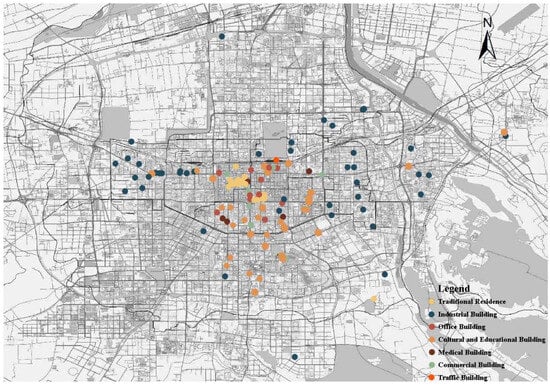
Figure 6.
Spatial distribution of historic buildings in Xi’an.
1. Historic buildings are mostly concentrated in the main urban area, and the cultural and educational historic buildings are mainly distributed in the south of the city. In contrast, the industrial historic buildings are mainly distributed in the east and west of the city. This arrangement is directly related to the urban pattern in the first round of Master Planning of Xi’an after the founding of New China.
2. Historic buildings are primarily distributed in discrete point shapes, with each protected object independent of the other and lacking organic connections. It is necessary to attach importance to the value of the building complex while considering its value to achieve the overall conservation of the urban historical environment on a larger scale.
3. The amount of the historic buildings is relatively small. As an essential component of the historic conservation area and the historic city, there are only 27 historic buildings within the 13.5 square kilometers (including three historic conservation areas), which needs to be further strengthened in terms of identification and conservation.
4. Research on the Value Evaluation of Historic Buildings in Xi’an
4.1. Methods and Steps for Value Evaluation of Historic Buildings
Based on a comprehensive investigation of historic building resources, qualitative and quantitative methods are used to evaluate and determine their comprehensive value, which is the key to the scientific process of historic building conservation [33]. At the same time, considering the applicability of different conservation stages and the operability of the evaluation system, the value evaluation of historic buildings needs to be carried out in phases and steps with multiple evaluations (see Figure 7). In the identification stage, the qualitative registration standards are used to quickly screen out valuable historic buildings through key value indicators to form a list of registered historic buildings. In the conservation and reuse stage after registering, a more systematic and explicit value indicator system is constructed to comprehensively evaluate the value of historic buildings, reflecting the value and grade through intuitive data and then determining practical issues such as conservation strategies, value orientations for reuse, and the level of renovation intervention.
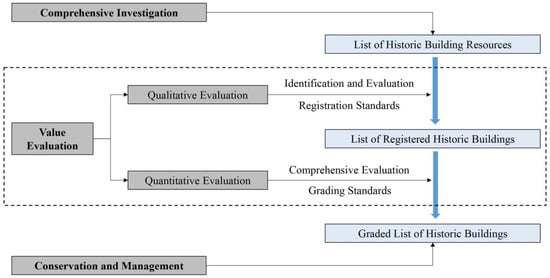
Figure 7.
Application of value evaluation in conservation process of historic buildings.
4.2. Identification and Evaluation of Historic Buildings in Xi’an
Like other types of heritage, the value of historic buildings determines whether they are worthy of conservation and how they should be conserved. The purpose of establishing the registration standards for historic buildings is to select and determine the list of registered historic buildings in Xi’an and to include these historic buildings with typical and representative value in the conservation system through registration.
4.2.1. Value Composition of Historic Buildings
As a newly expanded regional heritage conservation category, historic buildings still need to form a recognized and comprehensive value evaluation system. This study is based on the value composition of cultural relics buildings and combines the conceptual connotation, conservation, and reuse needs of historic buildings to divide the value types into three categories: basic value, core value, and subsidiary value (see Figure 8).
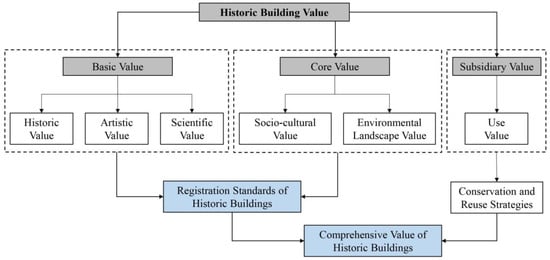
Figure 8.
Composition and relationship of the three value types of historic buildings.
- Basic values
The basic values are its historic, artistic, and scientific values, reflecting all aspects of information recorded and witnessed by historic buildings as objectively existing building entities, including historical, artistic, scientific, political, and economic aspects, which can be understood as the intrinsic value and attributes of historic buildings.
- Core values
Core values include socio-cultural value and environmental landscape value, which are the exclusive characteristics of historic buildings. The socio-cultural value reflects the connection between historic buildings and local culture, history, and environment, and has social and spiritual symbolic significance. At the same time, historic buildings, as a type of heritage conservation under the conservation system of the historic city, are an essential part of the city’s historical and cultural townscape, reflecting important environmental landscape values.
- Subsidiary value
The subsidiary value refers to the value of historic buildings being reused. Unlike cultural relics, historical buildings are abundant in quality and diverse in types, and most are still in use. Reasonable and sustainable reuse is the best way to conserve historic buildings [34].
4.2.2. Determination of Registration Standards for Historic Buildings in Xi’an
Taking the value composition of historic buildings as the core, combining with the historic contexts and the characteristics of historic building resources, and simultaneously referring to the writing pattern of national and multiple cities. The registration standards for Xi’an’s historic buildings are expressed as follows.
Buildings and structures that have one of the following conditions and have not been announced as officially conserved sites or registered as a result of national survey and inventory campaigns can be determined to be announced as historic buildings in Xi’an:
- Reflect the history, culture, and folkloric traditions of Xi’an, with specific time characteristics and regional features.
- Have pioneering or representative significance in the history of industrial development in China or Xi’an.
- Relate to significant political and economic, cultural and educational, military, and other historical events in China or Xi’an.
- Reflect regional architectural, historical, cultural, and artistic characteristics or have scientific research value in terms of architectural styles, patterns, structures, materials, construction process, or engineering technology.
- Representative works of famous architects.
- Former residences or monumental buildings of celebrities.
- Reflect the urban development of Xi’an with contemporary characteristics or landmarks.
- Constitute the overall features of the historic and cultural city of Xi’an.
4.3. Comprehensive Value Evaluation of Historic Buildings in Xi’an
A secondary evaluation is necessary to understand the value of historic buildings in Xi’an deeply and comprehensively and implement their conservation and reuse, which is a comprehensive value evaluation. Firstly, the analytic hierarchy process (AHP) is used to establish the hierarchical structure model of the historic building value evaluation system, and then the Delphi method is used to conduct an expert questionnaire survey to determine the index weight; finally, the fuzzy comprehensive evaluation method (FCEM) is introduced to carry out the fuzzy evaluation of the comprehensive value, which serves as a reference for the conservation and reuse methods and strategies of historic buildings.
4.3.1. Construction of Xi’an Historic Building Value Evaluation Index System Based on AHP Method
The AHP structure model can structure and layer the complex evaluation objects with multi-objective and multi-factors and obtain explicit judgments on complex decision-making problems [35]. Referring to the previous scholars’ index system for evaluating the value of architectural heritage and comprehensively considering the characteristics of historic buildings, such as the continuity of history and culture, the regionality that varies from city to city, the integrity of the urban environment, and the adaptability of functional continuity, a comprehensive value index system for historic buildings in Xi’an is constructed, which is divided into three layers (see Figure 9): goal layer, criteria layer (six items) and indices layer (nineteen items). This system is proposed for the conservation and reuse of historic buildings in Xi’an, which not only considers the conservation requirements but also reflects the need for reuse and meets the purpose of comprehensive evaluation of historic buildings.
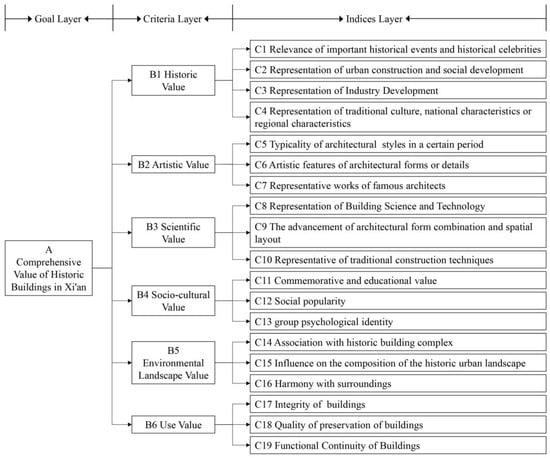
Figure 9.
Value evaluation index system of historic buildings in Xi’an.
4.3.2. Determination of Index Weight Based on the AHP and Delphi Methods
The importance of index factors at each layer in the value evaluation index system of Xi’an historic buildings is inconsistent, so it is necessary to determine the different weight coefficients of each index. The main steps are briefly described below:
- Establish a structural model for the value evaluation of historic buildings in Xi’an.
- Design expert questionnaires and obtain original data through pairwise comparison of indicators in each layer.
- Construct a judgment matrix [36].
- Check matrix consistency.
- Hierarchical sort.
With the help of SPSS, the questionnaire data of ten experts were counted, and the consistency check and data adjustment of the judgment matrix were carried out, so as to obtain the weight of each index. The specific weight is shown in Table 5. Finally, it was concluded that the ten experts surveyed by the questionnaire relatively concentratedly believed that “B1 Historic Value” (0.3517) > “B2 Artistic Value” (0.1776) > “B5 Environmental Landscape Value” (0.1577) > “B4 Socio-cultural Value” (0.1327) > “B6 Use Value” (0.0919) > “B3 Scientific Value” (0.0885).

Table 5.
Index weights and scoring standards of historic buildings in Xi’an.
4.3.3. Fuzzy Evaluation of the Comprehensive Value of Historic Buildings in Xi’an
FCEM is a comprehensive evaluation method based on fuzzy mathematics. According to the membership theory, qualitative evaluation is transformed into quantitative evaluation, and an overall evaluation is made of things or objects restricted by various factors [37]. The application of FCEM helps to understand and highlight the value of historic buildings, discover the existing deficiencies, and increase the scientificity of evaluation. According to the characteristics and conditions of historic buildings in Xi’an, experts are organized to score the value indices of each building. The specific scoring standards are shown in Table 5. The quantitative assignment of each indicator is between 0–10, with 0 being the lower-limit value, and 10 being the full-score value, of which 0–2 is very poor, 3–4 is poor, 5–6 is average, 7–8 is good, and 9–10 is excellent. Experts scored according to the relevant information and the actual situation of the current situation survey. Then they imported the scoring data of ten experts with the help of SPSS to calculate the results of group decision-making. After data inspection and correction, the calculation results of the comprehensive value of historic buildings can be obtained.
4.3.4. Case Study of Comprehensive Value Evaluation
Taking the historic buildings of Xi’an University of Architecture and Technology (Case 1), the building complex of Shanxi Old Steel Plant (Case 2), and Yu Youren’s former residence (Case 3) as examples, the comprehensive value of three different types of typical buildings in Xi’an historic building list is compared and analyzed. Among them, Case 1 was built in the 1950s to 1960s, and it consists of three parts (see Figure 10): the main building, the east building, and the west building. The planning and design are exquisite, and the architectural style is simple and dignified. The Chinese simplified bucket arches and column bases are perfectly combined with Western carvings and roofs. It is an example of the university campus layout in the early years of the founding of the People’s Republic of China. Case 2 was built in the 1950s and was once a key production enterprise in the national metallurgical industry (see Figure 11). After the bankruptcy in 2002, the entire factory was adapted, and its functions were changed from the original forging factory to creative industry parks, universities, and museums (see Figure 12). Case 3 was the residence of Yu Youren (1879–1964) in Xi’an, a modern Chinese statesman, educator, and calligrapher. It was built in the early 20th century and is a three-entry courtyard with a brick–timber structure consisting of a gate room, garden, hall, main room, and backyard. The descendants rebuilt it into a memorial hall in 2009, and the architectural style and form are well preserved (see Figure 13).
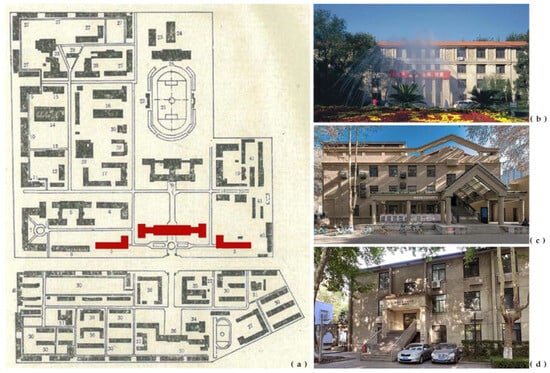
Figure 10.
The building complex in Xi’an University of Architecture and Technology: (a) general layout in 1955; (b) the main building; (c) the east building; (d) the west building.
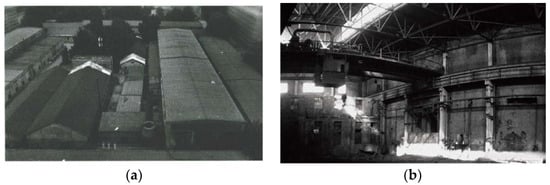
Figure 11.
The original appearance of Shanxi Old Steel Plant: (a) bird’s-eye view of the factory area; (b) inside the workshop.
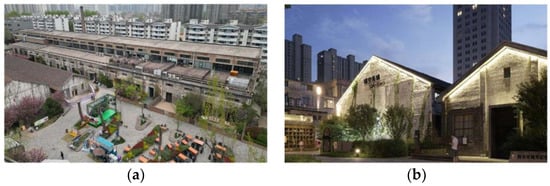
Figure 12.
Current status of the Shanxi Old Steel Plant after conversion and reuse: (a) public leisure space; (b) city memory museum.
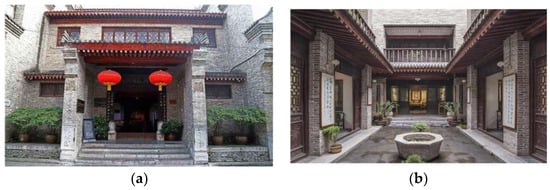
Figure 13.
The former residence of Yu Youren: (a) street room facade; (b) courtyard.
A fuzzy evaluation of the comprehensive value of the three historic buildings was carried out and the final scores were ranked as follows: Case 3 (7.2744) > Case 1 (6.8187) > Case 2 (6.3857). Then, comparing the value indices of each layer will give a clearer understanding of the value characteristics of each building. By comparing the indices of the same building, we can see the value order of the indices of the building. Taking Case 1 as an example, the scores of the indices at the criterion layer in Figure 14 reflect that the use value of the buildings of Xi’an University of Architecture and Technology is the most prominent, which is specifically reflected in the scores of C17, C18, and C19 in Figure 15. Each building is in a good current situation with integrity. The three buildings have continued their teaching and office functions since their completion. At the same time, by comparing the scores of different buildings on the same index, we can recognize the difference in the value performance of this index in different buildings. Taking the C4 index in Figure 15 as an example, it can be seen that Yu Youren’s former residence, as a traditional residential historic building, is more prominent in the representation of traditional culture, ethnic characteristics, or regional characteristics. So, the conservation and adaptation should focus on preserving and highlighting the value elements that reflect the characteristics of the traditional residence in Guanzhong district and the features of times.

Figure 14.
Score comparison of value indices at the criterion layer.
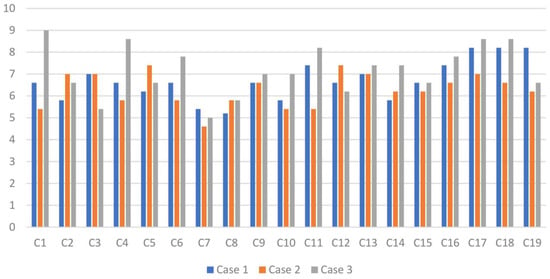
Figure 15.
Score comparison of value indices at the indices layer.
5. Conclusions
The starting point of this study is the census and identification of historic buildings in Xi’an. Through a large number of historical literature studies and current situation investigation, it summarizes the current characteristics and main problems of historic building resources in Xi’an. On the basis of the existing architectural heritage evaluation system, a registration standard for historic buildings in Xi’an is established based on the characteristics of historic buildings in this inland city. As a complex system of interconnected factors, the conservation and reuse of historic buildings are difficult to accurately calculate in their comprehensive value evaluation, regardless of any technical means used. All we can do is approach its comprehensive value as closely as possible, so it is very appropriate to apply AHP and FCEM to this study. It helps to establish systematicity in complex hierarchical relationships and transform qualitative evaluations into quantitative ones, increasing the scientificity of evaluation. This study supplements the gap in research on the general heritage of non-significant value in the ancient capital of Xi’an and enriches the connotation and extension of the urban heritage system of Xi’an. Specific conclusions are as follows:
- The historic building resources in Xi’an are primarily modern and contemporary buildings with typical regional characteristics and align with the features of modern history and culture in Xi’an, playing a significant role in the continuity of urban culture in the ancient capital of Xi’an.
- The ten experts who received the questionnaire in this study relatively concentratedly believed that in the value evaluation system of historic buildings, in addition to the historic value and artistic value that exist as the basic value of architectural heritage, historic buildings generally pay more attention to the environmental landscape value and socio-cultural value, which is directly related to the integrated conservation concept of the historic city and the emphasis on historical and cultural conservation and inheritance in urban and rural construction.
- In the process of comprehensive value evaluation of historic buildings, we should not only look at the results of the comprehensive accumulation of all indices but also consider the sub-indexes’ performance. By analyzing the hierarchical characteristics of the value system, we can fully grasp the advantages and disadvantages of historic buildings in terms of art, humanities, environment, and functions, to conform to the correct value orientation in the conservation and reuse methods and strategies and guide the rationalization of conservation and reuse.
This study puts forward the method and fundamental process of investigating historic building resources in Xi’an. It establishes a historic building investigation registration form directly related to the registration standards and value evaluation indices. On this basis, according to the current characteristics of historic buildings in Xi’an, and the different conservation stages, the value evaluation is divided into two steps: identification evaluation and comprehensive evaluation. The former constructs the registration standard of historic buildings in Xi’an, which provides a basis for identifying and publishing the conservation list. The latter combines the needs and characteristics of the conservation and reuse of historic buildings to establish a technical route for the quantitative evaluation of the comprehensive value of historic buildings in Xi’an. Finally, combined with three typical cases of different types of buildings, the evaluation results are well verified by reality.
It should be noted that this study also has some limitations. Since the research on architectural heritage has a considerable degree of social science attributes, this study introduces AHP, Delphi, and FCEM through quantitative statistical calculation, which dramatically increases the objectivity and scientificity, but still cannot avoid the subjective experience and judgment of experts. In addition, the survey scope of the current study mainly focuses on the central urban area of Xi’an, and further census should be conducted in the surrounding districts, counties, and villages in order to have a comprehensive understanding of the status of historic building resources. This paper studies the value composition and evaluation methods of historic buildings in Xi’an, which is not only a supplement to the theory of architectural heritage conservation, but also an exploration of the practice of conservation and reuse to provide reference and inspiration for the conservation of historic buildings in Xi’an and even the whole country. In the future, it is hoped that the local government can continue to explore and publish the list of registered historic buildings in Xi’an, develop new paths for historic building conservation and management, improve regulations and systems for the conservation and reuse of historic buildings, fully leverage the comprehensive value of historic buildings, and continue the historic contexts of the city.
Author Contributions
D.L.: conceptualization, methodology, writing—original draft; J.W.: resources, validation, supervision, writing—review, funding acquisition; K.S.: investigation, software, data curation. All authors have read and agreed to the published version of the manuscript.
Funding
This research was funded by the National Key R&D Program of China [Theory of Coupled Synergy between Greening Renovation and Landscape Enhancement of Historic Buildings] (No. 2022YFC3803500) and the National Natural Science Foundation of China [The Endogenous Mechanism of Cultural Ecology in Historical Areas of Silk Road Cities and Its Suitability Renewal Planning Model] (No. 52078404).
Data Availability Statement
Not applicable.
Conflicts of Interest
The authors declare no conflict of interest.
References
- Junhua, S. A Study on Preservation History and Present Condition of Church Buildings Constructed from Late-19-Century to Mid-20th-Century at Shaanxi Area. Master’s Thesis, Xi’an University of Architecture and Technology, Xi’an, China, 2006. [Google Scholar]
- Ying, F. Research on Xi’an Modern Architecture (1840–1949). Ph.D. Thesis, Xi’an University of Architecture and Technology, Xi’an, China, 2010. [Google Scholar]
- Zhixiang, X.; Jun, W. The tragedy of the ancient city: Analysis of the current situation and problems of the conservation of traditional dwellings in Xi’an. World Archit. 2022, 9, 14–18. [Google Scholar]
- Fang, W.; Haozhong, Y. The preservation of modern architecture heritage and the historical culture inheritance: Taking Xi’an as an example. Huazhong Archit. 2010, 12, 141–143. [Google Scholar]
- Xiaomin, W.; Fan, L.; Xinwen, W. The cultural heritage protection in the process of urbanization: The historic city of Xi’an as an example. Huazhong Archit. 2014, 3, 144–148. [Google Scholar]
- Ting, D. Conservation Study and Practice of Qixian Village. Master’s Thesis, Xi’an University of Architecture and Technology, Xi’an, China, 2007. [Google Scholar]
- Wenjing, A. A Study on the Historical and Cultural Block of Beiyuanmen in Xi’an and Its Spatial Construction. Ph.D. Thesis, Shaanxi Normal University, Xi’an, China, 2021. [Google Scholar]
- Jun, W.; Qijun, T. A study on the situation, problem and countermeasure of the conservation and utilization of historic buildings in Xi’an. Contemp. Archit. 2020, 8, 48–51. [Google Scholar]
- Guangya, Z.; Lixia, Y. Confusion and thoughts on the conservation and management of historic buildings. J. Archit. 2010, 2, 18–22. [Google Scholar]
- Zilai, T. Historical evolution of the core law of urban planning in the United Kingdom. Urban Plan. Int. 2000, 1, 10–12. [Google Scholar]
- Alain, M.; Kai, Z. Practice in reappearance of the value of urban cultural heritage in France. Time Archit. 2000, 3, 14–16. [Google Scholar]
- Judith, B.; Tianqi, H. Conservation of architectural heritage in Canada. World Archit. 1987, 6, 54–57. [Google Scholar]
- Tyler, N. Historic Preservation: An Introduction to Its History, Principles, and Practice; W.W. Norton & Co.: New York, NY, USA, 2000; pp. 95–99. [Google Scholar]
- Mingyu, H. Evaluation and Documentation in Cultural Heritage Conservation. Master’s Thesis, Fudan University, Shanghai, China, 2009; pp. 85–87. [Google Scholar]
- Gang, S.; Changming, Y. Re-examining on the value assessment system of modern architectural heritage. Archit. J. 2013, S2, 198–201. [Google Scholar]
- Qing, C. Reflection on the fundamental category of heritage architecture. Herit. Archit. 2016, 1, 44–61. [Google Scholar]
- Jinliang, X. Reconsideration on the value system of architectural heritage. China Anc. City 2018, 4, 71–76. [Google Scholar]
- Jiaguang, Z.; Nan, L.; Kejie, W. On the conservation list of BEIJING outstanding modern and contemporary architectures. City Plan. Rev. 2008, 10, 38–41+49. [Google Scholar]
- Danxia, F. Preservation Strategy for excellent modern architectures in Nanning. Planners 2014, 30, 181–186. [Google Scholar]
- Xunxiang, Q. Exploration of the cultural value of local architecture: Taking the traditional settlements in Shenzhen Dapeng Peninsula as example. Archit. J. 2011, 4, 16–18. [Google Scholar]
- Tingwan, H.; Dayu, Z. Research on the evolution of selection indicators and value assessment of Chinese traditional villages. City Plan. Rev. 2022, 46, 72–77. [Google Scholar]
- Boying, L.; Kuang, L. Formation of industrial heritage and method of value evaluation. Archicreation 2006, 9, 24–30. [Google Scholar]
- Jian, Z.; Qian, S.; Yuan, L. The preliminary study on industrial heritage value standard and suitability of reuse pattern. Archit. J. 2011, S1, 88–92. [Google Scholar]
- Nan, J. Techniques and methods for value evaluation of industrial heritage based on adaptive reuse. New Archit. 2016, 3, 4–9. [Google Scholar]
- Jixiang, S. Practice and exploration of 20th century heritage conservation. City Plan. Rev. 2008, 6, 11–32+43. [Google Scholar]
- LEI, J. Identification and Value Analysis of 20th Century Architectural Heritage Projects in China. China Cult. Herit. Sci. Res. 2018, 1, 14–19. [Google Scholar]
- Hongxia, Y.; Xiaohui, L. Evaluation on historic and cultural blocks in Qingdao and strategies for sustainable development. City Plan. Rev. 2014, 38, 65–69. [Google Scholar]
- Xuechun, L.; Qingli, D.; Guangya, Z. Fuzzy comprehensive evaluation on the comprehensive value of urban and rural historical area in China. J. Southeast Univ. 2002, 2, 44–46. [Google Scholar]
- Hui, Y.; Xiao, L. Appraising method of comprehensive value of historic buildings based on grey clustering method. Sichuan Build. Sci. 2009, 35, 240–242. [Google Scholar]
- Xijing, W. Research on the Conservation and Reuse of Industrial Architectural Heritage in Xi’an; China Construction Industry Press: Beijing, China, 2011; pp. 35–37. [Google Scholar]
- Xinke, L.; Lanxiang, L. History of Education in Xi’an; Xi’an Press: Xi’an, China, 2005; pp. 5–9. [Google Scholar]
- Yu, S. Evolution of architecture modernization of Xi’an. J. Xi’an Univ. Archit. Technol. 2018, 50, 65–71. [Google Scholar]
- Nan, J.; Jianguo, W. Comprehensive Evaluation of Modern Architectural Heritage Conservation and Reuse; Southeast University Press: Nanjing, China, 2016; pp. 116–120. [Google Scholar]
- Lin, L. History and reflection of historic building protection system. Eng. Technol. 2016, 7, 16–17. [Google Scholar]
- Dong, D.; Qinghua, P.; Yan, W. Modern Integrated Evaluation Methods and Selected Cases; Tsinghua University Press: Beijing, China, 2008; pp. 12–15. [Google Scholar]
- Junping, Q. Theory Method Practice; Science Press: Beijing, China, 2010; pp. 28–29. [Google Scholar]
- Dequn, Z. Introduction to Systems Engineering; Science Press: Beijing, China, 2005; pp. 10–12. [Google Scholar]
Disclaimer/Publisher’s Note: The statements, opinions and data contained in all publications are solely those of the individual author(s) and contributor(s) and not of MDPI and/or the editor(s). MDPI and/or the editor(s) disclaim responsibility for any injury to people or property resulting from any ideas, methods, instructions or products referred to in the content. |
© 2023 by the authors. Licensee MDPI, Basel, Switzerland. This article is an open access article distributed under the terms and conditions of the Creative Commons Attribution (CC BY) license (https://creativecommons.org/licenses/by/4.0/).









